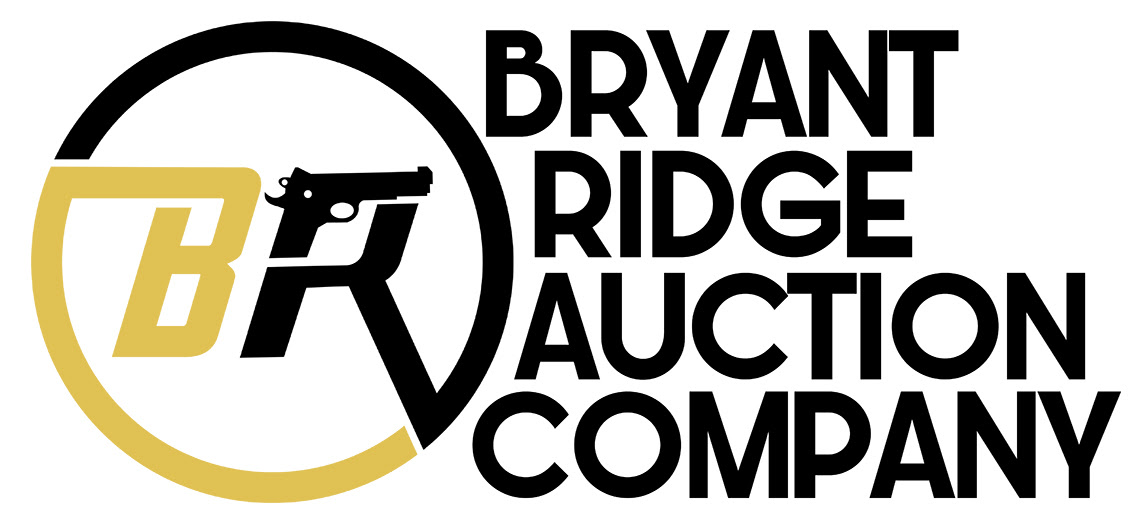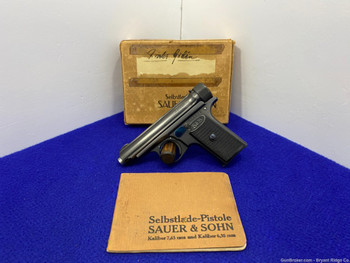Description

Item Description
Bryant Ridge Auction Company is pleased to present this uncommon semi-auto pistol today for a penny start auction, this is the J.P. Sauer & Sohn Model 1913!
SPECIFICATIONS:
Manufacturer: J.P. Sauer & Sohn
Model: Model 1913 2nd Variation
Serial: 119271
Date of Manufacture: 1913-1931
Caliber: .32 Auto
Finish: Blue
Barrel Length: 3"
Optics/Sights: Fixed Iron Sights
Stock/Grips: Black Checkered Hard Rubber
Action: Semi-Auto
Markings: Standard
Bryant Ridge's Analysis:
J.P. Sauer & Sohn of Suhl is the oldest firearm manufacturer in Germany, having been founded in 1751. The firm has produced all manner of firearms, including self-loading pistols starting around 1905, beginning with the 7.65 mm Browning-chambered (.32 ACP) Roth-Sauer repeater. This handgun, however, did not bear the Sauer imprimatur, and though the guns were marked with Sauer & Sohn’s name, they were not a Sauer design. That distinction would have to wait almost 10 years when the company came out with the first semi-automatic pistol devised and produced solely by Sauer & Sohn—the Selbstlade-Pistole Modell 1913.
This handy little .32 ACP, seven-shot blowback, designed by Heinz Zehner, was sturdy and compact. It possessed a fixed barrel around which was coiled the gun’s recoil spring. The slide contained a clever separate firing mechanism. To access the works, a large textured cocking knob, secured initially by a small detent and later by the pistol’s spring-loaded rear sight, was unscrewed. This allowed the breechblock to be extracted and the slide removed forward off the frame. The gun was striker-fired, the striker spring being held in position by a projection on the inside, center of the cocking knob. The magazine was secured by a heel catch, which was pushed forward to release it. Early versions had a magazine-safety button that locked their mechanisms when the magazines were removed; this feature was soon considered to be superfluous and was eliminated.
A traditional-style safety catch was mounted on the left side of the frame just behind the trigger. Initially, it only secured the trigger. Considered insufficient, a sear-blocking arrangement was added to later variants. Usual 1913s were marked on the top of their slides with Sauer & Sohn’s name and city of origin, along with a small image of the company’s logo of a wild man with a club. The cartridge designation was stamped on the right, rear of the slide and the word “PATENT” on the left. Some 1913s will also be seen with the name and address in English, presumably on guns intended for export. The pistols could be had with either blued (the most common) or nickel-plated finishes.
Stocks were of checkered hard rubber and, depending on when the gun was made, were either emblazoned with a simple “S&S” at their tops, an intertwined “S&S” in Gothic script within a large vertical oval or, finally, with “SAUER” and “Cal 7.65.” At first intended solely for the civilian market, with the advent of World War I, some 10,000 Model 1913s were procured by the German military. These will be found with acceptance proofmarks, as well as a standard crowned “N” commercial nitro proof. Such guns were normally reserved for officers. Circa 1925, the semi-automatic was given something of a facelift with a slight alteration in the slide shape and other cosmetic features. As nice a little pistol as it was, production of the Sauer ceased in 1931, having fallen victim to newer advanced designs such as the Walther PP. By the time of its demise, some 175,000 1913s had been built.
Contents:
This ABSOLUTELY JAW-DROPPING example will ship with the original box manual, and ALL contents pictured above!
Return Policy:
We gladly offer a 3 day unfired inspection policy from the time that the firearm is delivered to your FFL. Refunds are available for all qualifying orders.
Model: Model 1913 2nd Variation
Serial: 119271
Date of Manufacture: 1913-1931
Caliber: .32 Auto
Finish: Blue
Barrel Length: 3"
Optics/Sights: Fixed Iron Sights
Stock/Grips: Black Checkered Hard Rubber
Action: Semi-Auto
Markings: Standard
Bryant Ridge's Analysis:
J.P. Sauer & Sohn of Suhl is the oldest firearm manufacturer in Germany, having been founded in 1751. The firm has produced all manner of firearms, including self-loading pistols starting around 1905, beginning with the 7.65 mm Browning-chambered (.32 ACP) Roth-Sauer repeater. This handgun, however, did not bear the Sauer imprimatur, and though the guns were marked with Sauer & Sohn’s name, they were not a Sauer design. That distinction would have to wait almost 10 years when the company came out with the first semi-automatic pistol devised and produced solely by Sauer & Sohn—the Selbstlade-Pistole Modell 1913.
This handy little .32 ACP, seven-shot blowback, designed by Heinz Zehner, was sturdy and compact. It possessed a fixed barrel around which was coiled the gun’s recoil spring. The slide contained a clever separate firing mechanism. To access the works, a large textured cocking knob, secured initially by a small detent and later by the pistol’s spring-loaded rear sight, was unscrewed. This allowed the breechblock to be extracted and the slide removed forward off the frame. The gun was striker-fired, the striker spring being held in position by a projection on the inside, center of the cocking knob. The magazine was secured by a heel catch, which was pushed forward to release it. Early versions had a magazine-safety button that locked their mechanisms when the magazines were removed; this feature was soon considered to be superfluous and was eliminated.
A traditional-style safety catch was mounted on the left side of the frame just behind the trigger. Initially, it only secured the trigger. Considered insufficient, a sear-blocking arrangement was added to later variants. Usual 1913s were marked on the top of their slides with Sauer & Sohn’s name and city of origin, along with a small image of the company’s logo of a wild man with a club. The cartridge designation was stamped on the right, rear of the slide and the word “PATENT” on the left. Some 1913s will also be seen with the name and address in English, presumably on guns intended for export. The pistols could be had with either blued (the most common) or nickel-plated finishes.
Stocks were of checkered hard rubber and, depending on when the gun was made, were either emblazoned with a simple “S&S” at their tops, an intertwined “S&S” in Gothic script within a large vertical oval or, finally, with “SAUER” and “Cal 7.65.” At first intended solely for the civilian market, with the advent of World War I, some 10,000 Model 1913s were procured by the German military. These will be found with acceptance proofmarks, as well as a standard crowned “N” commercial nitro proof. Such guns were normally reserved for officers. Circa 1925, the semi-automatic was given something of a facelift with a slight alteration in the slide shape and other cosmetic features. As nice a little pistol as it was, production of the Sauer ceased in 1931, having fallen victim to newer advanced designs such as the Walther PP. By the time of its demise, some 175,000 1913s had been built.
Contents:
This ABSOLUTELY JAW-DROPPING example will ship with the original box manual, and ALL contents pictured above!
Return Policy:
We gladly offer a 3 day unfired inspection policy from the time that the firearm is delivered to your FFL. Refunds are available for all qualifying orders.
Shipping Details
Handgun Standard Shipping $50.00
Long Gun Standard Shipping $70.00
Any orders placed with magazines that are not compliant with your state, county, or city regulations will not ship with your order.
















